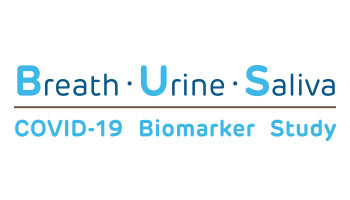HOW CAN WE HELP YOU? Call 1-800-TRY-CHOP
In This Section
Where Breath Meets Bark: Canines Collaborate With Scientists to Identify COVID-19 Biomarkers

The BUS study will help CHOP and Penn researchers develop a novel method to detect COVID-19 infections.
limjr [at] email.chop.edu (By Jillian Rose Lim)
Canine companions from the Penn Vet Working Dog Center are joining researchers at Children’s Hospital of Philadelphia in an effort to develop a novel method to detect COVID-19 infections. As the working dogs utilize their powerful sense of smell, scientists will harness a technique called mass spectrometry analysis to identify compounds associated with the virus in a big biomarker discovery project.
Findings from all labs – that is, the lab of Audrey Odom John, MD, PhD, and the Labradors of the Working Dog Center and their friends, could help identify the biomarkers needed to develop a “breathalyzer” test for COVID-19. Such a device would be noninvasive and capable of detecting compounds specific to individuals infected with SARS CoV-2, the coronavirus that causes COVID-19.
Dr. John, who is chief of the Division of Infectious Disease at CHOP, is no stranger to analyzing breath compounds associated with disease. In the last several years, her team conducted clinical studies in Malawi and Kenya to identify compounds produced by the malaria parasite. Now, Dr. John believes there’s a ripe opportunity to do something similar for COVID-19.
“We were already experts in both collecting breath from children and then analyzing the compounds that are present,” Dr. John said. “It's really rather remarkable. The average human breath has somewhere between 200 and 300 different compounds that are present. There's actually a lot of information.”
When a person exhales, their breath may release molecules called volatile organic compounds (VOCs), also found in sweat and urine, that researchers can sample quickly and noninvasively. In some diseases, these VOCs may function as biomarkers, as the compounds can indicate changes to a person’s clinical state. Certain VOCs, for example, have been suggested to represent biomarkers for asthma or lung cancer. Researchers previously looked at volatile compounds produced in cultured cells infected with the flu and other respiratory diseases.
“We think that it’s a scientifically feasible problem to see if COVID-19 infection also changes the volatiles that are present in breath,” Dr. John said.
As her lab began to develop a protocol for the analysis of compounds in SARS CoV-2, Dr. John received a timely question from Cynthia Otto, DVM, PhD, of the Working Dog Center: Could working dogs perhaps sniff out COVID-19?
Sniffing Out Answers
Dogs have an incredibly sensitive sense of smell, and have long helped in search and rescue missions, law enforcement, and the detection of certain medical conditions, including cancer and infections. In fact, past studies have shown dogs can detect low concentrations of disease-associated VOCs present in urine, blood, and exhaled breath.
With the Working Dog Center on board, Dr. John’s team plans to begin the Breath, Urine, Saliva (BUS) Covid-19 Biomarker Study by collecting breath, urine, and saliva from children with and without a SARS CoV-2 infection. The lab will then conduct unbiased metabolite profiling and investigate what compounds are present in both the breath and the urine.
But identifying whether or not the researchers are seeing a clear signal between infected and uninfected children in a mass of information can be difficult – and this is where their furry four-legged counterparts come in.
“What the dogs are great at is telling you whether or not there’s a signal there,” Dr. John said. “So, you can imagine, if you have a really complicated mixture of 300 different things, and some things are going up and some down in one set of children versus another, it’s a lot of information.”
For a dog, however, the readout of such information is binary.
“The dogs either signal that they smell it, or they don’t,” Dr. John said. “They do the math much better, essentially. And while I think it's probably not what would ultimately be used as a diagnostic device in the clinic – much as I would like dogs in the clinic – I think what the dogs allow us to do is get to the answer the quickest.”
One of the questions Dr. John and her team would like to answer, for example, is whether the urine of children with a COVID-19 infection carries a different scent than those without. If the working dogs indicate that it does, then that might justify her team doing a much bigger study in multiple centers to figure out the exact compound that the dogs smell.
“If the dogs can't tell the difference, my guess is the mass spectrometer ultimately won't either,” Dr. John said.
A Breathalyzer for COVID-19?
The complementary studies will inform each other, aimed toward Dr. John’s ultimate end goal: development of a rapid, noninvasive method to detect asymptomatic or mildly symptomatic COVID-19 infection.
Thanks to advances in volatile sensors and electronic nose technologies (devices capable of detecting complex mixtures of VOC’s), such a method could look like a COVID-19 breathalyzer: a low-cost, field-stable diagnostic device that utilizes breath biomarkers to detect SARS CoV-2-specific VOC’s.
Dr. John’s research already has yielded such success in malaria: Using just six breath biomarkers, her team successfully diagnosed malaria noninvasively with over 82 percent accuracy in Malawian children.
If development of a detection test for COVID-19 is successful, it could help to alleviate the burden of current testing methods that are expensive, limited, and time-consuming for labs.
For now, however, recruitment for the current study is set to begin soon, with enrollment open for any child admitted to CHOP with a confirmed COVID-19 infection during the pandemic.